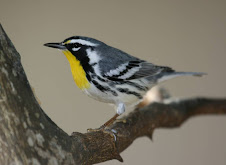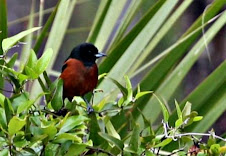
Yellow-bellied Flycatcher

Red-breasted Nuthatch

Brown-headed Nuthatch

Black-throated Green Warbler
Northern Flicker
Glenda writes....
This past week-end, Bonnie Nielsen and I had a wonderful trip out to Fort Morgan in Gulf Shores, Al, to observe banding of migrating birds by The Hummerbird Study Group. This was my third such trip and Bonnie's first...but won't be her last!
As usual, Fred Bassett, Bob and Martha Sargent and the rest of the HBSG banding crew welcomed and bedazzled us with their vast knowledge and gentle handling of these beautiful birds. I can't speak highly enough about this wonderful organization and their commitment to the study and preservation of hummingbirds and other migrating birds. And they are all non-paid volunteers! Andy previously listed their website, but here it is again.
www.hummingbirdsplus.org
Below is a list of birds that Bonnie and I saw banded in our day and half visit and some of their pictures.
Glenda Simmons
-------------------------------------------------------------------------------------------------
1) Magnolia Warbler-many, both sexes
2) Wood Thrush-many
3) House Wren-several
4) Blue-gray Gnatcatcher-several
5) Carolina Chickadee
6) Pine Warbler-male and female
7) Gray Catbird-many
8) Common Yellowthroat, several, both sexes
9) Indigo Bunting, several females
10) Red-eyed vireo
11) Bay-breasted Warbler
12) Chuck-Will's-Widow
13) Eastern Towhee, female
14) American Redstart, juvenile male
15) Black-throated Green Warbler, several, both sexes
16) Black-and-white Warbler, male and female
17) Yellow-bellied Flycatcher
18) Yellow-rumped Warbler
19) White-eyed Vireo
20) Red-breasted Nuthatch
21) Oven Bird
22) Eastern Phoebe
23) Northern Cardinal, female
24) Brown-headed Nuthatch, several
25) Tennessee Warbler, female
26) Blue Grosbeak, female
27) Swainson's Thrush
28) Ruby-Crowned Kinglet, several
29) Northern Flicker, female
(Bonnie saw a Yellow-billed Cuckoo & Yellow-breasted Chat)
We also saw a variety of shorebirds and songbirds in the trees and Broad-winged Hawks soaring overhead. The only disappointment, for me, was not seeing a hummingbird; however several had been banded before we arrived. Before we left, three more birders from Tallahassee arrived, Fred Dietrich, Pam Flynn and Tracee Strohman, so hopefully they will be adding more birds to this list.
.jpg)

















